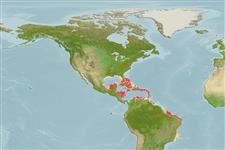>
Blenniiformes (Blennies) >
Chaenopsidae (Pike-, tube- and flagblennies)
Etymology: Emblemariopsis: Latin, emblema = insertion, inlaid work, raised ornament + Greek, opsis = appearance (Ref. 45335).
Environment: milieu / climate zone / depth range / distribution range
Écologie
marin récifal; profondeur ? - 20 m (Ref. 125603). Tropical
Western Atlantic: Bahamas, the Greater Antilles at Cuba, Dominican Republic, and Puerto Rico; down the Lesser Antilles chain (the Virgin Islands, St. Martin, Saba, St. Eustacius, St. Kitts, and Nevis;documented at the Cayman Is., San Andres, and Little Corn Island, Nicaragua, and Panama.
Taille / Poids / Âge
Maturity: Lm ? range ? - ? cm
Max length : 2.6 cm SL mâle / non sexé; (Ref. 125603)
Description synthétique
Morphologie | Morphométrie
Épines dorsales (Total): 19 - 22; Rayons mous dorsaux (Total): 11-15; Épines anales 2; Rayons mous anaux: 21 - 23. This species without an orbital cirrus or a red banner is distinguished by the following characters: TP territorial males found in holes with a black head; the anterior dorsal fin is plain black without a white rim; first dorsal-fin spine is very short, when adpressed reaching to 4th spine base, about 1/4 HL, the subsequent spines rising to midfin spines; occasionally a short row of small dark spots along anterior lateral midline, occasionally an irregular row of dark spots along proximal membranes of spinous dorsal fin (Ref. 125603).
Dark-shaded, pale, and transitional TP have very short first dorsal-fin spine, that when adpressed reaches to 4th spine base, with subsequent spines rising to midfin; usually with an irregular row of dark spots along proximal spinous-dorsal fin membranes, often indistinct; occasionally with a short row of small dark spots along anterior lateral midline; no opercular bands or lines; the reduced head markings often only a dark band from eye across jaw, sometimes a moustache band at rim above maxilla (Ref. 125603).
IP with very short first dorsal-fin spines, the first spine when adpressed reaching to base of 3rd or 4th spine base, spines rising sharply to midfin spines. Colouration: live colors red, orange, and pink; the cranial pattern a Y-shape: whith a rounded red band 1, band 2 a prominent Y with pale arms and a red stalk, a reduced band 3 often just one, sometimes two, isolated spots or segments, a long pale band 4 becoming red towards the midline, band 5 inconspicuous; IP head spots are reduced, typically only a band from eye across jaws, sometimes a spot at corner of jaw; melanophores near pectoral-fin base are usually diffuse, occasionally one or two spots (Ref. 125603).
Inhabit small patch reefs surrounded by fine white sand (Ref. 5521). It is usually found on live corals or gorgonians, often photographed nestled in the grooves of brain corals, with the TP males occupying holes in live corals or sponges; depth range extends to 20 m at least (Ref. 125603).
Life cycle and mating behavior
Maturité | Reproduction | Frai | Œufs | Fécondité | Larves
Victor, B.C., 2020. Review of the glass blennies (Teleostei: Chaenopsidae: Emblemariopsis) with two new species from the Caribbean Sea. J. Ocean Sci. Foundation 37:1-122. (Ref. 125603)
Statut dans la liste rouge de l'IUCN (Ref. 130435)
Menace pour l'homme
Harmless
Utilisations par l'homme
Plus d'informations
Noms communsSynonymesMétabolismePrédateursÉcotoxicologieReproductionMaturitéFraiRassemblement de ponteFéconditéŒufsDéveloppement de l'œuf
Taille/ÂgeCroissanceLongueur-poidsLongueur-longueurFréquences de longueursMorphométrieMorphologieLarvesDynamique des populations larvairesRecrutementAbondanceBRUVS
RéférencesAquacultureProfil d'aquacultureSouchesGénétiqueElectrophoresesHéritabilitéPathologiesTraitementNutrientsMass conversion
CollaborateursImagesStamps, Coins Misc.SonsCiguateraVitesseType de nageSurface branchialeOtolithesCerveauxVision
Outils
Articles particuliers
Télécharger en XML
Sources Internet
Estimates based on models
Preferred temperature (Ref.
123201): 26.5 - 28.2, mean 27.5 °C (based on 580 cells).
Phylogenetic diversity index (Ref.
82804): PD
50 = 0.5001 [Uniqueness, from 0.5 = low to 2.0 = high].
Bayesian length-weight: a=0.00457 (0.00183 - 0.01143), b=3.08 (2.86 - 3.30), in cm total length, based on LWR estimates for this (Sub)family-body shape (Ref.
93245).
Niveau trophique (Ref.
69278): 3.2 ±0.5 se; based on size and trophs of closest relatives
Fishing Vulnerability (Ref.
59153): Low vulnerability (10 of 100).
Nutrients (Ref.
124155): Calcium = 276 [117, 620] mg/100g; Iron = 1.01 [0.52, 1.97] mg/100g; Protein = 17.8 [16.4, 19.0] %; Omega3 = 0.113 [0.050, 0.248] g/100g; Selenium = 13.5 [4.9, 37.6] μg/100g; VitaminA = 647 [167, 2,531] μg/100g; Zinc = 2.85 [1.67, 4.59] mg/100g (wet weight);
